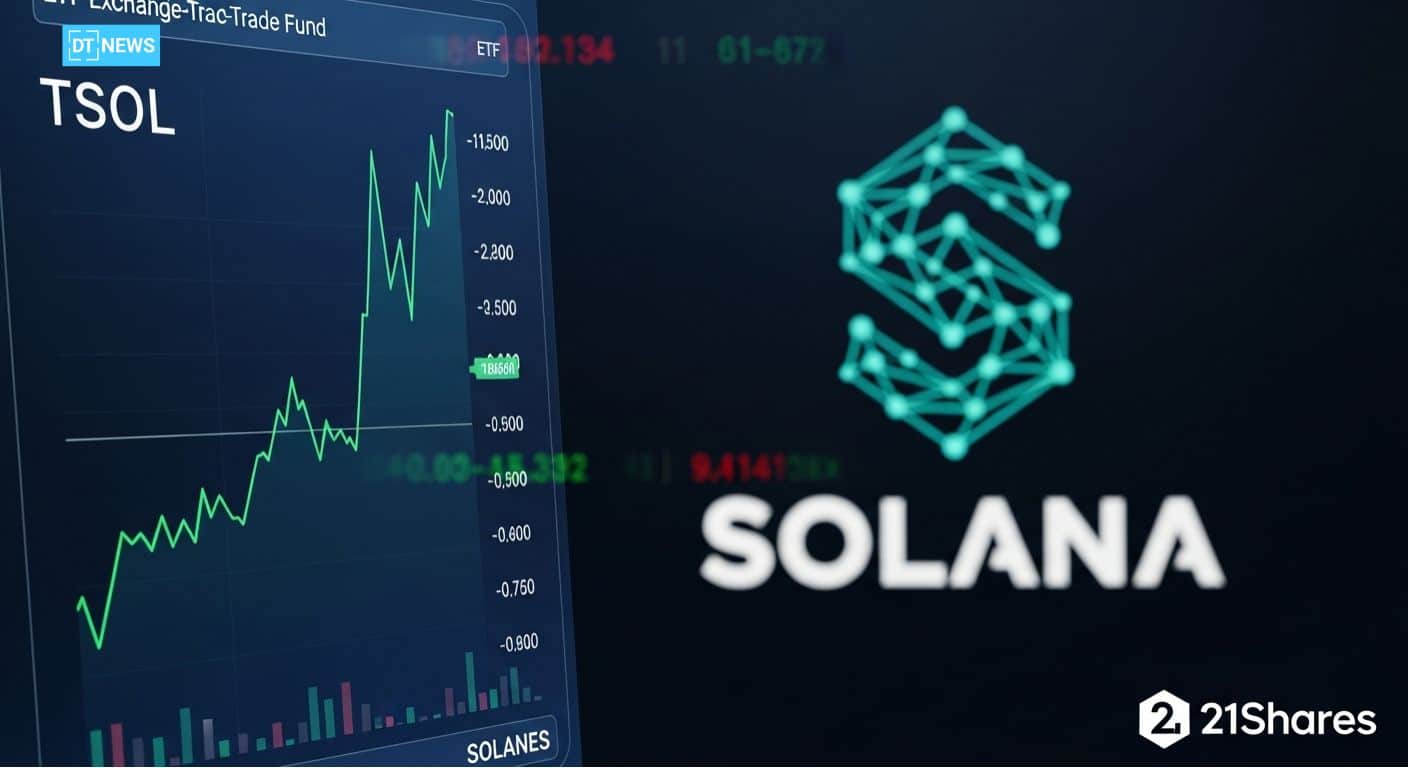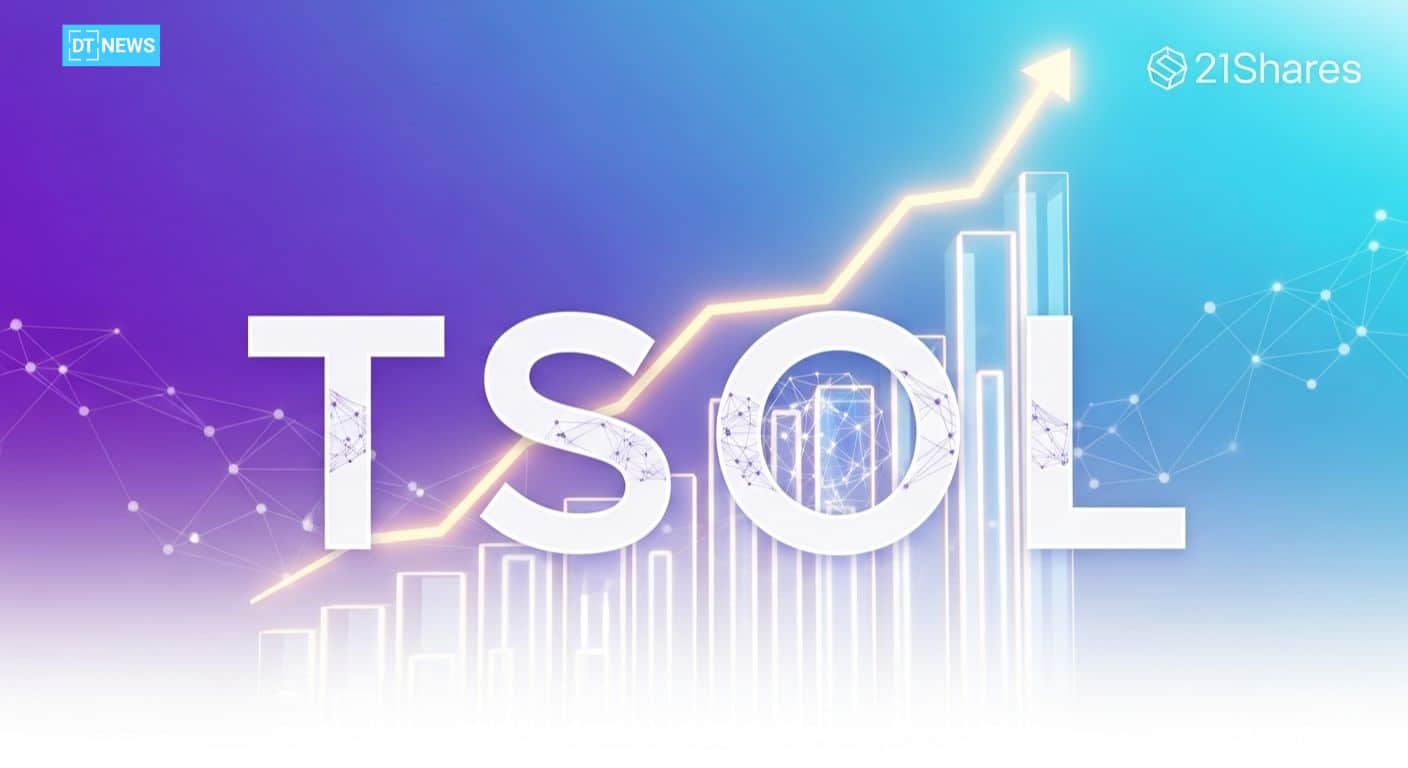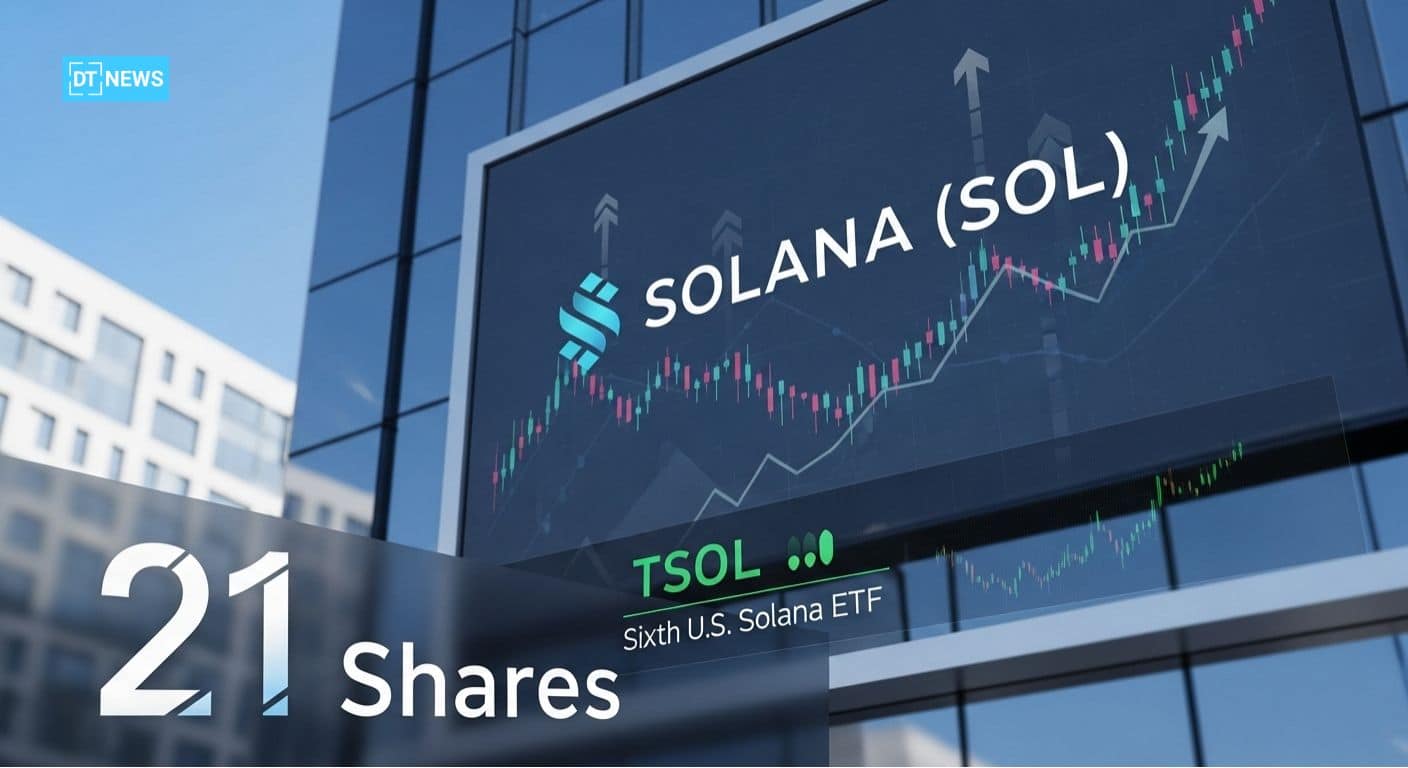This article was first published on Deythere.
- TSOL Debut: What Investors Need to Know
- The Competitive Landscape: Six Solana ETFs Now Available
- Staking Component: Yield Meets Accessibility
- Institutional Demand and ETF Flows
- Conclusion
- Glossary
- Frequently Asked Questions About 21Shares Solana ETF
- What is TSOL?
- How much does TSOL charge?
- Is TSOL staking its $SOL?
- Why is the Solana ETF ecosystem growing so quickly?
- How important are ETFs to Solana’s ecosystem?
- References
21Shares has taken a huge step by rolling out TSOL, its long-awaited Solana ETF, on the Cboe BZX Exchange.
By coming to market, TSOL becomes the sixth U.S.-listed Solana ETF in direct competition with its peers like Bitwise (BSOL), Grayscale (GSOL), VanEck (VSOL), Fidelity (FSOL) and Canary’s own SOLC.
The product reflects not only Solana’s price, but also staking, an ability for investors to capture yield from $SOL’s native staking rewards. Its cheap fee of 0.21% also supports 21Shares’ effort to offer a cost-competitive, yield-enabled product.
With institutional demand for Solana increasing, TSOL entering the market is a sign of confidence in both Solana’s ecosystem and its future potential.
TSOL Debut: What Investors Need to Know
TSOL debuted November 19, 2025, making 21Shares the sixth issuer of a U.S. Solana ETF.
The ETF is trading on the Cboe BZX Exchange under the ticker TSOL. 21Shares points out that TSOL isn’t just a spot play on SOL, it also stakes its holdings to capture on-chain rewards.

The fund’s total expense ratio (TER) is 0.21%, which compares favorably in the cash-based ETF altcoin sector.
TSOL had about $100 million in assets under management when it launched, market analysts said.
The size indicates real intent from 21Shares and early investor interest. With TSOL, U.S. investors can have regulated exposure to Solana’s high-throughput blockchain while potentially earning staking yield, a combination that few existing alternatives provide.
The Competitive Landscape: Six Solana ETFs Now Available
By bringing TSOL to market, 21Shares has expanded the U.S. Solana ETF race.
The current lineup includes: BSOL by Bitwise (dominant in AUM), GSOL by Grayscale, VSOL by VanEck, FSOL by Fidelity, SOLC by Canary Capital and TSOL by 21Shares.
Bitwise’s BSOL accounts for more than 80% of the Solana-ETFs market share, showing just how far other issuers have to go to compete. But TSOL’s low fee and staking functionality make it a unique, possibly appealing alternative for retail and institutional investors alike.
The crowded and expanding space illustrates how the institutional demand for Solana exposure is strengthening. Investors get both innovation and more selection, as additional issuers compete.
Staking Component: Yield Meets Accessibility
One of the standout feature in TSOL is its staking of Solana, a trend among many altcoin ETFs. By staking SOL, TSOL’s fund operator can earn on-chain rewards, and ideally that income would accrue to investors or at least add to the ETF’s economics).
21Shares even makes this plain in its launch announcement, which describes TSOL as providing “direct exposure to Solana’s ecosystem … with staking to capture yield.”
This staking model is similar to how other Solana products function. 21Shares, for example, already has a Solana Core Staking ETP (CSOL) in Europe that is backed by SOL and automatically reinvests staking rewards back into the product.

Institutional Demand and ETF Flows
21Shares is introducing TSOL when interest in Solana from institutions has been high. According to sources, Solana ETFs have witnessed strong inflows in Solana ETFs recently, despite broader market turmoil.
More specifically, sources noted that net inflows for U.S. Solana ETFs totaled $55.61 million.
These inflows indicate that institutional investors are using the SOL price dips as opportunities to accumulate.
The wider Solana ETF category seems to be growing up quickly. The fact that six issuers are now competing is an indication of confidence in SOL’s value over the longer-term.
Conclusion
21Shares’ TSOL ETF is a notable breakthrough in the Solana ETF race in the U.S. It’s the 6th entrant and comes with competitive fees, staking offerings and institutional grade structure.
As 21Shares puts it, TSOL represents “the latest addition to its growing U.S. crypto ETP lineup … and provides U.S. investors with the opportunity to diversify exposure through one of the world’s most powerful blockchains.”
With substantial inflows and interest from larger-scale issuers, TSOL could drive Solana’s institutional adoption further, opening on-chain yield for a broader investor base.
Glossary
ETF (Exchange-Traded Fund): A fund that holds assets, such as cryptocurrency or stocks, and trades on an exchange like a stock to give investors exposure to them.
Staking: Locking a proof-of-stake blockchain’s native token (like SOL) to help the network run and earning rewards for it.
Expense Ratio: The percentage of a fund’s average assets that is used to cover the fund’s normal operating expenses for the year.
AUM (Assets Under Management): The total market value of assets that a fund or ETF oversees.
ETP / ETP Provider: Exchange-traded product; a company that issues ETFs, trusts, or similar instruments for assets.
Lock-up: When tokens are staked, or in some way rendered illiquid temporarily, thus limiting the supply available for trading.
Frequently Asked Questions About 21Shares Solana ETF
What is TSOL?
TSOL is the 21Shares Solana ETF, which was recently added for trading on Cboe BZX. It just provides that SOL price direct exposure and then staking benefits structure.
How much does TSOL charge?
TSOL is a relatively inexpensive fund with a total expense ratio of 0.21%.
Is TSOL staking its $SOL?
Yes, TSOL stakes its $SOL to earn on-chain rewards that also can add extra returns.
Why is the Solana ETF ecosystem growing so quickly?
There’s growing institutional demand for Layer-1 exposure, yield from staking and regulated access to Solana via ETFs. 21Shares and others are trying to cater to that trend.
How important are ETFs to Solana’s ecosystem?
ETFS like TSOL help add capital and legitimacy to Solana that could drive long-term network investment and on-chain utility.



















































































































